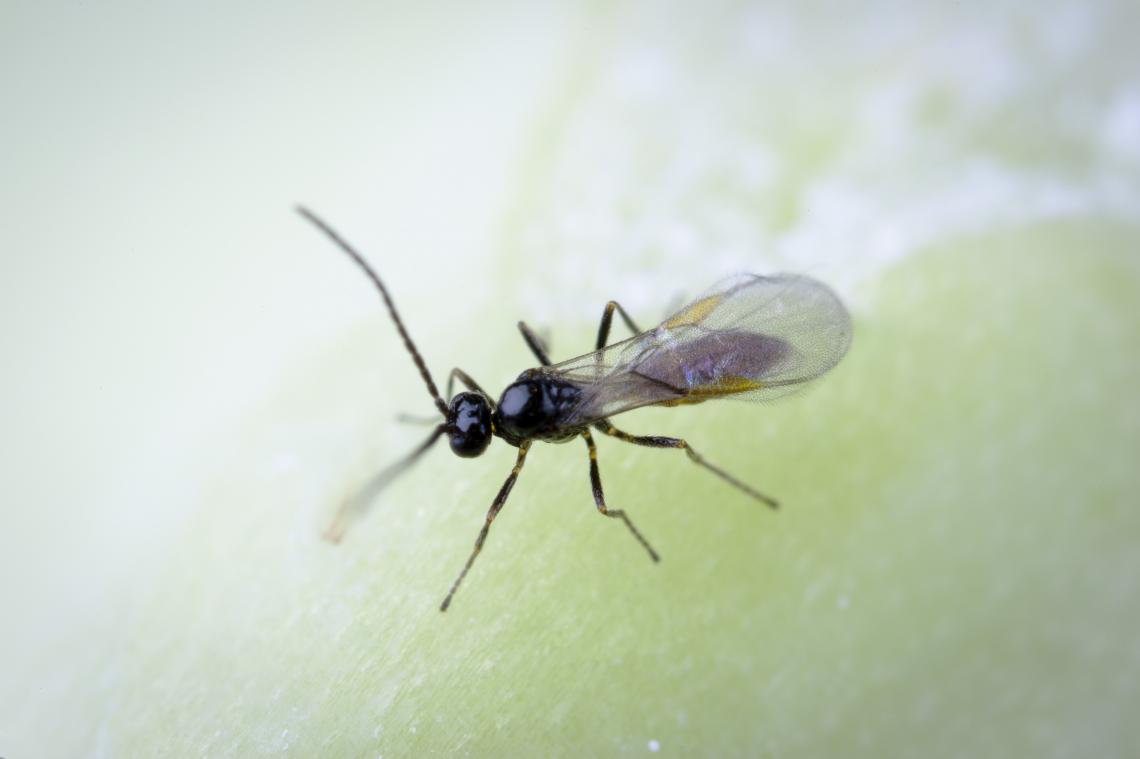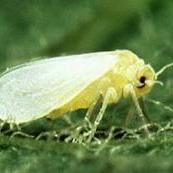Diaeretiella Diaeretiella rapae
Diaeretiella rapae is a primary parasite of cabbage aphid (Brevicoryne brassicae), turnip aphid (Lipaphis pseudobrassicae) and green peach aphid (Myzus persicae). These three aphid species are all key pests of brassicas, making D. rapae the most important biocontrol agent for aphids in these crops. D. rapae can also attack cereal aphids such as corn-leaf aphid, Russian wheat aphid, and other key aphid species including cotton/melon aphid (Aphis gossypii).
Description and life cycle
Diaeretiella rapae are about 2-3mm long. Their head and thorax are black and their abdomen and legs are a yellowish brown. Highly effective foragers, D. rapae can stop the establishment of aphid colonies and help prevent aphid outbreaks. Early introduction when pests are at low levels leads to the best pest regulation.
Studies have shown that D. rapae can effectively target aphids at all stages of their development. Aphid nymphs younger than 4 days produce no offspring after parasitism. In a research study, the average number of offspring per aphid parasitised at day 5 and day 7 (adults) was 3.1 and 15.3 respectively – much less than unparasitised aphid offspring (38.1). Each parasite can lay up to 175 eggs (120-140 eggs on average). The eggs are deposited inside the aphid and hatch within 2-3 days. The larva feeds on the aphid from the inside, pupating within the aphid carcass (a ‘mummy’). A few days later it emerges as an adult wasp to continue the parasite life cycle.
At 20°C the D. rapae lifecycle, from egg to adult, takes 12-13 days. Females live for 10-15 days and males for 7-10 days.
Suitable crops
D. rapae can be used to control aphids in all brassica crops including cabbage, broccoli, cauliflower, canola, radishes, Chinese cabbage, and other brassica greens. They can be used in both indoor and outdoor crops. Due to their ability to control a range of aphid species they can also be useful in other crops such as corn, cotton, cereals and greenhouse vegetables.
When to release
Diaeretiella rapae work best if they are released as soon as aphids are detected. Studies have shown D. rapae to have a high searching ability and good parasitism rates when aphid levels are low and dispersed. Early establishment helps prevent a rapid increase of aphid populations in spring. D. rapae can also alternate successfully between many hosts. Its populations can be sustained by using shelter belts with a polyculture of plant species.
How to release
D. rapae are supplied in vials with 500 parasited pupae (mummies) per vial. Some wasps may emerge during transit and most will have hatched within 2-3 days of recieval. Open the lids of vials in the crop zones where aphids are present and allow parasites to fly into the crop. The remaining contents can be sprinkled over the foliage where aphids are likely to be present. Larger areas of field crops such as canola can have aphid mummies released utilising various drone/aircraft technologies.
Release rates
Field crop inoculations vary depending on the expanse of the crops treated. Low-level inoculations of 500/ha into field canola/cereal crops can be enough to establish D. rapae. Where aphid populations are already established and crops are of high value 2-5000 wasps/ha should be released several times on a weekly basis.
Chemical use
D. rapae is sensitive to many pesticides, particularly pyrethroids, organophosphates and neonicotinoids. Residues on foliage and greenhouse structures may remain toxic for many weeks and negatively impact on their survival and ability to effect control. Check side-effects charts carefully and avoid using pesticides before and during D. rapae use unless they are known to be safe. There are a range of fairly specific aphid pesticides that are compatible with the parasites if needed. Contact Biological Services for specific information.
Ordering and accounts
Orders are sent via express courier services on Monday or Tuesday of each week, and usually arrive within a couple of days. Orders received after noon on Tuesday are sent the following Monday. Prices are on a sliding scale i.e. the more that is purchased over a monthly period, the lower the price will be per unit. Freight is charged at Express parcel cost. Accounts are sent at the end of each month, and can be paid by EFT, BPay, cheque or postal order.

Related pests
- Cabbage aphid
- Cotton/melon aphid
- Green peach aphid
- Turnip aphid
Related crops
- Brassicas
- Cereals
- Cotton





